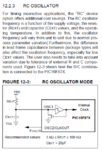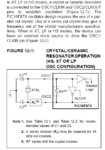amitaiwe
Member level 3
Hi,
In the pic16f877 data sheet is written:
"The RC oscillator
frequency is a function of the supply voltage, the resistor
(REXT) and capacitor (CEXT) values, and the operating
temperature. In addition to this, the oscillator
frequency will vary from unit to unit due to normal process
parameter variation."
The frequency value is derived from a capacitor and resistor values.
Q1. Is there any way that I can now approximately what will this frequency
be? I want to write a code in advance before I get the pic and
I want to know which value to enter into the SPBRG register so to
determine the baud rate. ( Baud Rate = FOSC/(4(SPBRG+1) )
Q2. will the output frequency be fosc/4 as seen in the diagram?
Thanks, Amitai

In the pic16f877 data sheet is written:
"The RC oscillator
frequency is a function of the supply voltage, the resistor
(REXT) and capacitor (CEXT) values, and the operating
temperature. In addition to this, the oscillator
frequency will vary from unit to unit due to normal process
parameter variation."
The frequency value is derived from a capacitor and resistor values.
Q1. Is there any way that I can now approximately what will this frequency
be? I want to write a code in advance before I get the pic and
I want to know which value to enter into the SPBRG register so to
determine the baud rate. ( Baud Rate = FOSC/(4(SPBRG+1) )
Q2. will the output frequency be fosc/4 as seen in the diagram?
Thanks, Amitai


